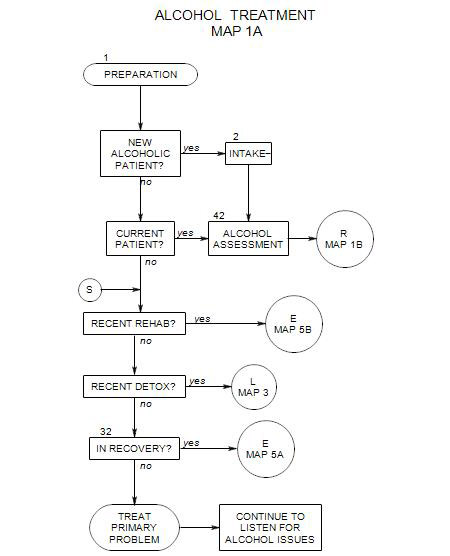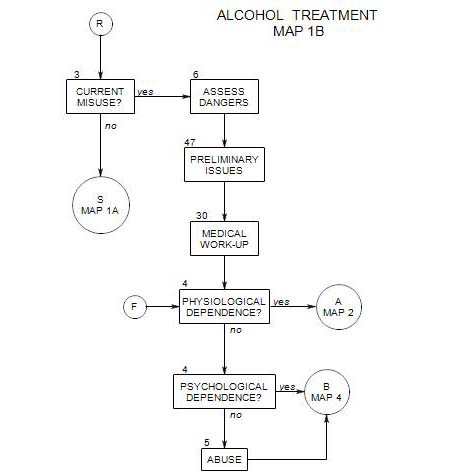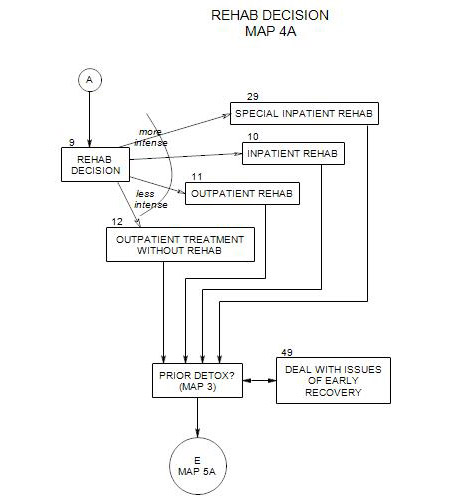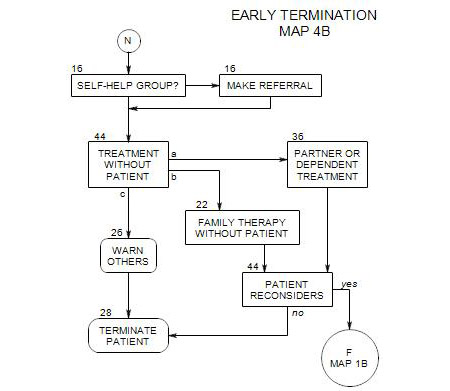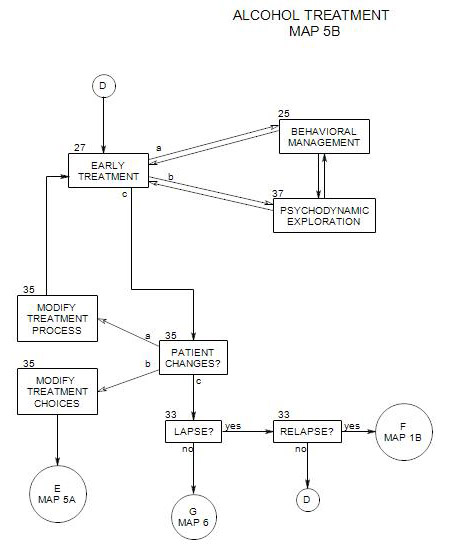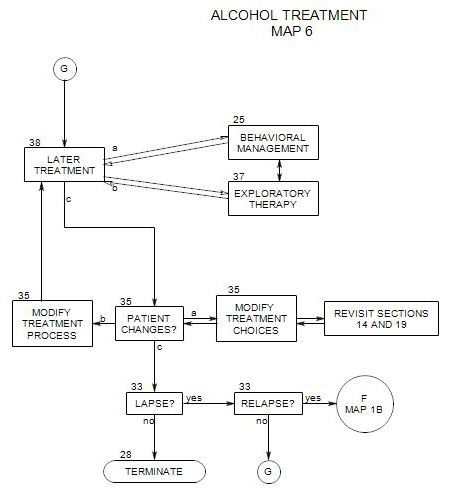This issue can come up in several places in treatment, when the identified patient refuses to, or is unable continue, and his/her drinking remains a serious problem for self and others. Family therapy that includes the patient is discussed in Section 22 and partner therapy in Section 36.
The issue here is treatment for others in the family of an alcoholic patient, when the identified patient [IP] is unwilling or unable to come for therapy. The IP may be an active alcoholic or somewhere in the recovery process. The problem is to decide whether something can still be done to help the IP and/or others in the patient’s family. In this case, it is important to keep your therapeutic goals in mind, and expect that the goals may change over time. Broadly speaking, therapeutic goals can be focused on the IP, others in the family, or the family as a whole.
44a. The Choices
THERAPY
Depending on family needs and therapeutic resources, you have three broad choices at this point:
- ¾You can try family therapy without the patient, to work on issues that have an impact on everyone.
- ¾You can work with other family members, either on their own individual issues or on their relationships with the IP.
- ¾If neither of these is possible or likely to have a positive impact, you may be forced to terminate the case and notify all family members of your decision.
SELF HELP
Whether you work with other family members or not, self-help groups are commonly available to provide support, personal insight and strategies for dealing with an alcoholic. Notable among these are Al-Anon and Alateen, which are discussed in Section 19. These groups tend to be supportive of psychotherapy for members, and they can also stimulate new directions in a person’s individual psychotherapy.
PROS AND CONS
Treatment without the IP can provide both opportunities and risks. You may be able to predict some of these for a particular patient and his/her family; others not.
Opportunities can include:
- Others may contribute important information about the background of the IP that he/she would withhold or might not know.
- Others can monitor the daily life and reactions of the IP to treatment, which can be useful for evaluating treatment effectiveness and making changes in the treatment plan.
- Others may need help for their own issues.
- Others in the family may be more reliable and motivated to work.
- Others will be interacting with the IP every day, while therapy is typically only once or twice weekly. Treatment may have a more pervasive and consistent effect when it comes through other family members.
- The family may be on the way to dissolution, regardless of therapeutic involvement. Working with others may help them end a dysfunctional system, begin their own work, and work toward independence.
Risks can include:
- Others may refuse to participate in treatment because they don’t see that there is a problem, they are afraid of outside interference in the family, they are afraid of the IP’s reaction to their participation, or for a variety of other reasons.
- Other family members may lack authority in the mind of the IP, and be ignored, dismissed or rejected when they attempt to make changes.
- Some alcoholic patients may be enraged by the idea that others are talking about him/her. Great caution must be taken when there is a possibility of self-destructive behavior or interpersonal violence.
- The IP may feel abandoned by the therapist and excluded by other family members, and drink or withdraw from the family.
- You may lose track of the perspective of the IP, and miss important intrapsychic issues that could affect his/her treatment. On the other hand, if the IP won’t or can’t come for therapy, you wouldn’t have direct access to these issues anyway.
- Others may be tired of the IP’s drinking and related behaviors [excessive spending, job losses, violence, etc.] and take this moment to withdraw all support.
- Working with others may lead to violations of the IP’s boundaries or confidentiality or cause other risks to the therapeutic relationship. However, addicts don’t always operate in their own long-term best interests, and a therapist’s job is to do what is best for the patient, not necessarily what the patient wishes. You may need to violate confidentiality or disturb boundaries on occasion. If so, it is generally better for you to inform the patient in advance and try to enlist his/her cooperation. Here again, a careful risk assessment is in order.
44b. Getting Started
This can present problems, depending on the patient’s personal issues and relationships with others in the family. A person who doesn’t want to participate in treatment may also not want others to be coming to you about him/her, and to engage them without permission may involve violations of confidence and trust. For more on this, see Section 36d.
Others must be convinced that treatment can be helpful. They have typically been living with the IP’s drinking for a long time and tried many ways to stop it, without success. They are typically doubtful that any therapy can be helpful, and need encouragement to try again. They may also blame the IP for all family dysfunction and be reluctant to examine their own parts in the process.
This is a time to evaluate the dangers, both of proceeding without the patient, and of terminating the case. If you decide to continue, you will need to work with family members on reducing any likely risks of interventions, especially in the form of patient reactions, and ways to handle dangers that might occur.
44c. Working With Individual Family Members
The direct effect of psychotherapy with another family member can have its own benefits for that person. It can also have an impact on the IP in many ways.
- The IP may have been drinking in part as a reaction to another’s unresolved issues [for example, intense dependency on the patient]. Helping the other person resolve them may relieve some pressure on the IP. As the other becomes more self-focused, the IP may flounder from the failure to obtain expected reactions and either increase objectionable behaviors or consider his/her own treatment more seriously.
- The other family member may become stronger and less tolerant of the IP’s drinking. As a consequence, the other may stop enabling the IP and force him/her to face the natural consequences of drinking.
- Therapy may help the other person work with the IP in taking positive steps to overcome his/her drinking problem.
However, if another family member goes into treatment, the question arises: With whom? Do you see the partner or dependent, or send that person to another therapist? The issues are complicated, and depend in part on whether the IP is likely to return to treatment or not. Some of these issues are discussed in Section 36c.
Whatever you decide to do, your choices should be made with the knowledge and participation of all who are involved. They should be aware of the options for treatment, recognize the pros and cons of the alternatives, and contribute to choosing the next step.
ENGAGING THE OTHER PERSON
Once you are working with another family member, you can involve him/her around a number of issues, including –
- his/her reactions to the IP and/or others in the family.
- concern for the IP and the consequences of drinking.
- methods for managing the IP.
- his/her own pain or other issues
- concerns about other family members who suffer the consequences of the alcoholic’s drinking behavior.
If the other family member needs to be persuaded to engage in therapy, there are a variety of ways to encourage participation. You can –
- ask about his/her own drug and alcohol use and history, and their implications and consequences.
- ask about the alcohol history of the IP, from the other’s perspective. This could include attempts to help the IP reduce or stop drinking, reactions to drinking, etc.
- ask about his/her other experience with alcohol in other people, including childhood. Suggest that there might have been a connection between the other’s history and choice of this IP, if that applies.
- suggest that changes the other makes can have an impact on the IP, so that work on him/herself can have double benefits.
- treat the other’s work as a consultation about the IP, at least to start.
- note that the alcoholic’s drinking and associated behavior has changed the other person, and that it will take self-work to return to a more “normal” way of life.
Partner or dependent treatment is also discussed in Section 36, where the assumption is that the IP is actively involved in treatment as well.
44d. Working with the Family on Family Issues
General advantages and disadvantages of family therapy are discussed in Section 14. In addition, family therapy without the IP can be helpful by –
- helping other family members support and defend each other in the face of the IP’s drinking and its consequences.
- helping others work together to manage the IP, to push him/her to go for treatment, or both.
- removing the IP from the center of family attention with its attendant rewards and rejections.
- helping others change and grow independently of the IP.
Here, as in working with other individuals in the family, the issue of who will be the family’s therapist must be addressed. It is common in family therapy to be fluid – to go back and forth among individual, couple and group work. When there is a background of cooperation and love, this can be very effective. When one or another family member is isolated from the rest, especially through intolerance and anger, it may be more difficult for the same therapist to make the transitions.
These and related issues are discussed in Section 22
44e. The Family as Behavior Therapists
There many ways to engage other family members in the treatment of an IP who is not actively participating [Miller, 2003, 146-7] One is the Community Reinforcement and Family Training [CRAFT] approach [Smith and Meyers, 2004; Smith, Meyers and Milford, 2003, 246-253]. You can think of the therapy as indirect, in that the therapist is working through other family members to treat the IP. However, the “Concerned Significant Others” or CSOs can also be considered to be the actual patients, who are faced with a common issue.
This approach involves several steps:
- First, the CSOs must be convinced that treatment can be helpful. They must be reassured that the program can work, through developing trust with the therapist, examining their own previous failed interventions, learning about successes of the program, and learning the components of the program.
- Next, the CSOs must learn some things that they can do, to reduce risks or leave, if the patient’s behavior becomes dangerous.
- A “functional analysis” of the IP’s drinking behavior, is completed, commonly in chart form. The chart shows [a] typical external triggers for the patient’s drinking; [b] the IP’s internal triggers, in the form of probable feelings or thoughts; [c] descriptions of the patient’s actual drinking behavior; [d] apparent short-term positive consequences of the drinking for the patient; and [e] long-term negative consequences of drinking for the patient and others.
- The functional analysis is then used to help CSOs determine where they can have an impact on the patient’s drinking behavior by disrupting the triggers of the IP or finding alternatives.
- Examination of the immediate positive consequences for the IP can suggest healthy alternatives that might be equally satisfying. The IP can also be rewarded for periods of sobriety in many ways, physical and verbal. New activities can be introduced that don’t involve drinking.
- A review of long-term negative consequences can be used by a CSO to express dissatisfaction with changes in their lives. This in turn can lead to a search for ways to regain some of the satisfactions of life that have been lost.
- Chances are that communication in the past has been mostly negative – criticism, nagging, etc., and ineffective. CSOs can be trained in positive communication skills, because those skills provide a basis for influencing the IP more effectively.
- At the same time, CSOs are encouraged to allow the negative consequences of the patient’s drinking to occur, without attempting to “fix” them.
- Friends and family members may be supported in other ways, by identifying any problem areas they have in their own lives and helping them find more satisfaction in those areas. This can strengthen them and help them find ways to be less enmeshed with the IP.
- Work can be done on ways to encourage the patient to go for treatment; however, this topic should only be broached when the patient is sober.
Some additional issues should be considered when considering this approach.
- A CSO who is using drugs or alcohol is not likely to be very effective modifying the IP’s behavior, both because he/she may have difficulty staying focused and forceful in carrying it out and because he/she is not a credible controller to the patient.
- A CSO who is regularly involved with the IP is more likely to be effective in carrying out the approach, because of being able to perform the needed reinforcements regularly and consistently.
- If the IP is prone to violence, it is not clear that this approach should be used. There is a strong possibility that the interventions will be frustrating to the IP and increase the likelihood of new violence.
44f. The Identified Patient [IP] May Reconsider Treatment
This option seems simple at first glance; after all, a major purpose in working with other family members, individually or together, is to get the IP sober and in treatment.
However, it raises new issues, including…
- Who is the patient? This definition may have changed in the course of working with others, and may no longer be the originally IP.
- Who is/are the therapist[s] for the IP and the others in treatment? This can be affected by your earlier choice of therapist[s] in the absence of the patient.
- What is the reaction of others to the patient’s reconsideration? They may welcome it and look forward to positive changes. They may also resent the patient’s change of heart and resist his/her attempts to “normalize” relationships. One of the therapist’s issues is to move all family reactions in the direction of long term positive change.
Preliminary issues may include –
- Examine the patient’s motives for returning to treatment. This examination may in itself be motivating to some patients – who perceive that they must now justify treatment that they previously experienced as being thrust upon them. Different kinds of treatment may follow from different motives for returning.
- Determine the current level of patient misuse as an indicator of how to proceed.
- See whether the patient’s background information has changed, and if so, what impact that may have on treatment choices.
44g. Terminating the case
If you are unable to help the IP, or work with others in the family, either individually or in a family therapy setting, then you may be forced to terminate the case. In this case, go to Section 28, and plan to follow up by informing all family members of your decision [ Section 26 ].
